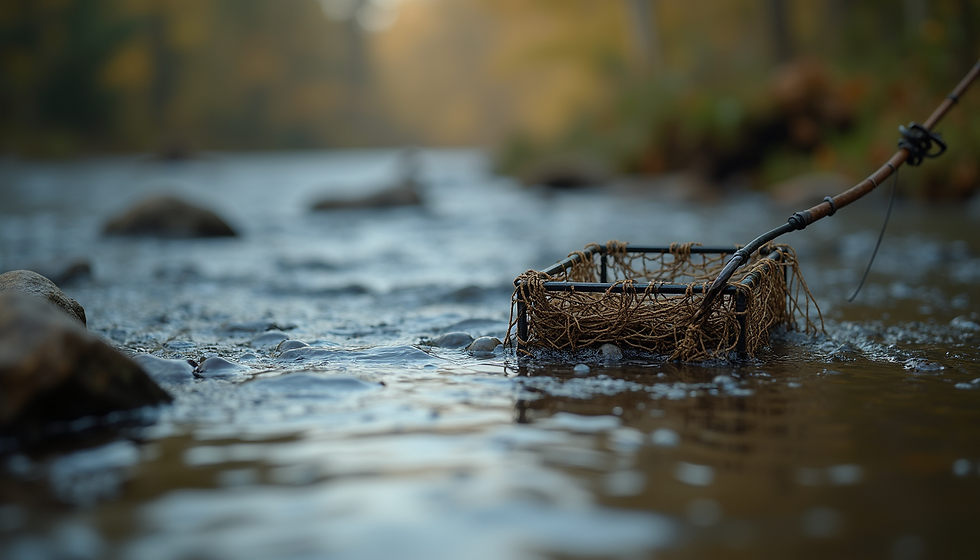Unleashing the Secret Techniques of Stealth Fishing: Mastering the Art of Catching Skittish Species
- Flying Fishman

- Mar 20
- 3 min read
Fishing is not just about the catch; it's about the experience and the thrill of the chase. When targeting skittish species, the excitement amplifies. These fish can be quick to flee at the slightest disturbance, making them a challenge to catch. In this post, we’ll explore the vital techniques of stealth fishing that can help you land those elusive fish that often evade our nets.
Understanding Skittish Species
Skittish fish, such as trout, bonefish, and certain bass, are known for their acute sensitivity to their environment. Studies show that fish like bonefish can perceive vibrations in the water from over 100 feet away. Their instinct to flee can kick in with the slightest noise or movement, making them difficult to catch. To improve your odds, it’s essential to understand their behavior.
These fish tend to feed more readily when they feel unthreatened. Factors like noise, shadows, and sudden movements can scare them off. Consider that a single loud splash can ruin the chances of a successful catch in a quiet spot.
Gear Selection for Stealth Fishing
Choosing the right gear is a pivotal part of stealth fishing. Here are some tips for selecting equipment that enhances your stealth approach:
Rods and Reels: Go for lightweight rods designed for sensitivity. A good choice is a 6 to 7-foot rod which allows for precision and feel, increasing your chances of detecting even the slightest nibble.
Line Selection: Use thin, low-visibility lines. A fluorocarbon line with a diameter of 6 to 8 pounds breaks the surface tension better and is harder for fish to notice. This can increase your catch rates by as much as 30%.
Smaller Baits: Opt for small baits that replicate natural prey. For instance, using a 2-inch soft plastic worm can often entice bites that larger, more aggressive lures simply cannot.
Mastering Your Approach
The way you enter a fishing area can make a world of difference. Here are effective strategies to avoid detection:
Quiet Movement: When approaching your fishing spot, walk slowly and minimize noise. Fishing in a kayak or quietly wading can help maintain a tranquil environment.
Crouch Down: Keep a low profile to blend in. Fish can be wary of any above-water movements, so crouching or even lying low can make it harder for them to spot you.
Observe Before Acting: Take time to watch the water surface for activity. Look for any signs of fish like swirl marks or breaking water. This helps you spot feeding fish and plan your approach carefully.
The Art of Casting
Your casting technique is critical in stealth fishing. Here are methods to refine your skill:
Longer Casts: Aim for longer casts to minimize your presence in the fish's immediate environment. A cast of 30 to 50 feet can keep you far enough away to avoid scaring fish.
Targeted Casting: Direct your casts to specific locations, such as under overhanging branches or near isolated rocks. This focused approach can yield a higher success rate than random casting.
Roll Casts: Perfecting the roll cast can improve your stealth. This method helps deliver your bait quietly and close to the water surface without plopping down noisily.
Timing Matters
The time you choose to fish can significantly influence your success. Here are crucial times to be aware of:
Early Morning and Dusk: Many skittish species are more active during these times, as they feed more confidently while the light changes. Studies have shown a 60% increase in catches during these hours compared to midday.
Weather Conditions: Overcast days can enhance feeding as fish are less vigilant. Cloudy conditions can lead to a 20% increase in feeding activity, thus improving your chances of a successful catch.
Patience is Key
Stealth fishing requires considerable patience. Here are effective ways to develop this important trait:
Spend Time Observing: Devote time to simply watching the water. Recognizing patterns in fish behavior can significantly improve your strategy, making waiting worth it.
Stay Still: After casting, minimize your movement. Settling in and remaining quiet is crucial as fish are often spooked by sudden actions. Enjoy the serenity, as waiting can lead to rewarding catches.
Final Thoughts
Stealth fishing is a rewarding challenge that blends skill, patience, and knowledge of fish behavior. By mastering stealth techniques, selecting appropriate gear, and honing your approach, casting skills, timing, and patience, you can significantly increase your chances of success with elusive skittish species.
Each fishing outing brings new lessons and experiences. The next time you set out, try applying these stealth fishing strategies, and embrace the adventure that awaits!

With practice and the right techniques, you’ll soon become a stealth fishing expert, ready to share stories of your adventures. Happy fishing!



